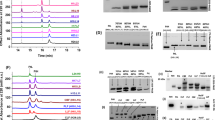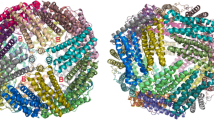Abstract
Ferritin has been studied in many animals, plants and bacteria. The main functions of ferritin in mammals are iron concentration and stabilization, protection against oxidants and iron storage for later developmental or iron-dependent activities. Although insect ferritin plays a key role in iron transport, only a few studies to date have examined its properties and function. Ferritin isolation from the haemolymph of adult Camponotus sericeiventris ants involved heating at 75 °C, followed by protein fractionation with 3.2 M KBr gradients and ferritin sedimentation with KBr. Protein identification was performed using high-resolution proteomics techniques. SDS-PAGE revealed three subunits with molecular weights (MW) of 26, 28 and 31 kDa. Native PAGE indicated a MW higher than 669 kDa. Proteomic analysis strongly suggested the 26 and 31 kDa bands as F2LCH and F1HCH subunits of ferritin, respectively. Ferromagnetic resonance (FMR) at 100 K showed, at low field, a characteristic broad component of the ferritin iron core, suggesting that its distribution was shifted to values greater than 3000, a higher content than in mammals. The protein yield and MW were comparable to those reported in other studies of insects. To the best of our knowledge, this is the first report on ferritin extracted from adult ants to date. These results are discussed on the basis of the protein structure–function relation of secreted insect and mammal ferritins. This purification method will allow the use of magnetic techniques, which are relevant for understanding the role of ferritin in the biomineralization of magnetic nanoparticles in insects.






Similar content being viewed by others
References
Alenkina IV, Oshtrakh MI, Klencsár Z, Kuzmann E, Chukin AV, Semionkin VA (2014) {57Fe} Mössbauer spectroscopy and electron paramagnetic resonance studies of human liver ferritin, Ferrum Lek and Maltofer®. Spectrochim Acta A Mol Biomol Spectrosc 130C:24–36. https://doi.org/10.1016/j.saa.2014.03.049
Arosio P, Ingrassia R, Cavadini P (2009) Ferritins: a family of molecules for iron storage, antioxidation and more. Biochim Biophys Acta Gen Subj 1790(7):589–599. https://doi.org/10.1016/j.bbagen.2008.09.004
Arosio P, Carmona F, Gozzelino R, Maccarinelli F, Poli M (2015) The importance of eukaryotic ferritins in iron handling and cytoprotection. Biochem J 472(1):1–15. https://doi.org/10.1042/BJ20150787
Atkinson BG, Dean RL, Tomlinson J, Blaker TW (1989) Rapid purification of ferritin from lysates of red blood cells using proteinase-K. Biochem Cell Biol 67(1):52–57. http://www.ncbi.nlm.nih.gov/pubmed/2713128
Bradley JM, Le Brun NE, Moore GR (2016) Ferritins: furnishing proteins with iron Topical Issue in Honor of R.J.P. Williams. J Biol Inorg Chem 21(1):13–28. https://doi.org/10.1007/s00775-016-1336-0
Capurro MDL, Iughetti P, Ribolla PE, de Bianchi AG (1996) Musca domestica hemolymph ferritin. Arch Insect Biochem Physiol 32(2):197–207
Charlesworth A, Georgieva T, Gospodov I et al (1997) Isolation and properties of Drosophila melanogaster ferritin—molecular cloning of a cDNA that encodes one subunit, and localization of the gene on the third chromosome. Eur J Biochem 247(2):470–475. http://www.ncbi.nlm.nih.gov/pubmed/9266686
Chasteen ND, Harrison PM (1999) Mineralization in ferritin: an efficient means of iron storage. J Struct Biol 126(3):182–194. https://doi.org/10.1006/jsbi.1999.4118
Chung MCM (1985) A specific iron stain for iron-binding proteins in polyacrylamide gels: application to transferrin and lactoferrin. Anal Biochem 148(2):498–502. https://doi.org/10.1016/0003-2697(85)90258-1
Cohen LA, Gutierrez L, Weiss A et al (2010) Serum ferritin is derived primarily from macrophages through a nonclassical secretory pathway. Blood 116(9):1574–1584. https://doi.org/10.1182/blood-2009-11-253815
Corpet F (1988) Multiple sequence alignment with hierarchical clustering. Nucl Acids Res 16(22):10881–10890
Cowley JM, Dawn EJ, Janney DE, Gerkin RC, Buseck PR (2000) The structure of ferritin cores determined by electron nanodiffraction. J Struct Chem 131:210–216. https://doi.org/10.1006/jsbi.2000.4292
de Oliveira JF, Wajnberg E, Esquivel DMDS, Weinkauf S, Winklhofer M, Hanzlik M (2010) Ant antennae: are they sites for magnetoreception? J R Soc Interface 7(42):143–152. https://doi.org/10.1098/rsif.2009.0102
Dunkov BC, Georgieva T (2006) Insect iron binding proteins: insights from the genomes. Insect Biochem Mol Biol 36(4 SPEC. ISS.):300–309. https://doi.org/10.1016/j.ibmb.2006.01.007
Gasdaska JR, Law JH, Bender CJ, Aisen P (1996) Cockroach transferrin closely resembles vertebrate transferrins in its metal ion-binding properties: a spectroscopic study. J Inorg Biochem 64(4):247–258. https://doi.org/10.1016/S0162-0134(96)00052-9
Gálvez N, Fernández B, Sánchez P, Cuesta R, Ceolín M, Clemente-León M, Trasobares S, López-Haro M, Calvino JJ, Stéphan O, Domínguez-Vera JM (2008) Comparative structural and chemical studies of ferritin cores with gradual removal of their iron contents. J Ann Chem Soc 130(25):8062–8068
Gould JL, Kirschvink JL, Deffeyes KS (1978) Bees have magnetic remanence. Science 201(12):1026–1028. https://doi.org/10.1126/science.201.4360.1026
Gutiérrez L, Zubow K, Nield J, Gambis A, Mollereau B, Lazaro FJ, Mirssilis F (2013) Biophysical and genetic analysis of iron partitioning and ferritin function in Drosophila melanogaster. Metallomics 5:997–1005
Hajdusek O, Sojka D, Kopacek P et al (2009) Knockdown of proteins involved in iron metabolism limits tick reproduction and development. Proc Natl Acad Sci 106(4):1033–1038. https://doi.org/10.1073/pnas.0807961106
Hamburger AE, West AP Jr, Hamburger ZA, Hamburger P, Bjorkman PJ (2005) Crystal structure of a secreted insect ferritin reveals a symmetrical arrangement of heavy and light chains. J Mol Biol 349:558–569. https://doi.org/10.1016/j.jmb.2005.03.074
Hsu CY, Chan YP (2011) Identification and localization of proteins associated with biomineralization in the iron deposition vesicles of honeybees (Apis mellifera). PLoS One 6(4). https://doi.org/10.1371/journal.pone.0019088
Hsu CY, Li CW (1994) Magnetoreception in honeybees. Science 265:95–97. https://doi.org/10.1126/science.265.5168.95
Hsu C-Y, Ko F-Y, Li C-W, Fann K, Lue J-T (2007) Magnetoreception system in honeybees (Apis mellifera). PLoS ONE 2(4):e395. https://doi.org/10.1371/journal.pone.0000395
Huebers HA, Huebers E, Finch CA et al (1988) Iron binding proteins and their roles in the tobacco hornworm, Manduca sexta (L.). J Comp Physiol B 158(3):291–300. http://www.ncbi.nlm.nih.gov/pubmed/3192782
Ibrahim MM, Edwards G, Seehra MS, Ganguly B, Huffman GP (1994) Magnetism and spin dynamics of nanoscale FeOOH particles. J Appl Phys 75(10):5873–5875. https://doi.org/10.1063/1.355545
Ikeya M (1993) New application of ESR, dating, dosimetry and microscopy. In: Zimmerman MR, Whitehead N (eds) Silica and silicates. Geotherm and vulcanism, Cap. 10. World Scientific Ed., Singapore
Jung JH, Eom TW, Lee YP, Rhee JY, Choi EH (2011) Magnetic model for a horse-spleen ferritin with a three-phase core structure. J Magn Magn Mater 323(23):3077–3080. https://doi.org/10.1016/j.jmmm.2011.06.060
Kim BS, Lee CS, Yun CY, Yeo SM, Park WM, Kim HR (2001a) Characterization and immunological analysis of ferritin from the hemolymph of Galleria mellonella. Comp Biochem Physiol A Mol Integr Physiol. 129(2–3):501–509. https://doi.org/10.1016/S1095-6433(01)00287-2
Kim BS, Yun CY, Yeo SM, Lee HJ, Kim HR (2001b) Cloning and expression of a ferritin subunit for Galleria mellonella. Arch Insect Biochem Physiol 47(1):8–17. https://doi.org/10.1002/arch.1030
Kim EY, Lee CS, Kim HR (2004) Purification and properties of ferritin from the last instar larval hemolymph of Protaetia brevitarsis (Coleoptera). Entomol Res 34(2):91–99
Kuterbach DA, Walcott B. (1986) Iron-containing cells in the honey-bee (Apis mellifera). I. Adult morphology and physiology. J Exp Biol 126(1):375–387. http://www.ncbi.nlm.nih.gov/pubmed/3805998
Laemmli UK (1970) Cleavage of structural proteins during the assembly of the head of bacteriophage T4. Nature 227(5259):680–685. https://doi.org/10.1038/227680a0
Lucano MJ, Cernicchiaro G, Wajnberg E, Esquivel DMS (2006) Stingless bee antennae: a magnetic sensory organ? Biometals 19(3):295–300. https://doi.org/10.1007/s10534-005-0520-4
Mandilaras K, Pathmanathan T, Missirlis F (2013) Iron absorption in Drosophila melanogaster. Nutrients 5(5):1622–1647. https://doi.org/10.3390/nu5051622
Nichol H, Locke M (1989) The characterization of ferritin in an insect. Insect Biochem 19(6):587–602. https://doi.org/10.1016/0020-1790(89)90024-3
Nichol H, Law J, Winzerling J (2002) Iron metabolism in insects. Annu Rev Entomol 47(1):535–559. https://doi.org/10.1146/annurev.ento.47.091201.145237
Ong ST, Shan Ho JZ, Ho B, Ding JL (2006) Iron-withholding strategy in innate immunity. Immunobiology 211(4):295–314. https://doi.org/10.1016/j.imbio.2006.02.004
Pham DQD, Winzerling JJ (2010) Insect ferritins: typical or atypical? Biochim Biophys Acta Gen Subj 1800(8):824–833. https://doi.org/10.1016/j.bbagen.2010.03.004
Pierre TGS, Tran KC, Webb J et al (1991) Organ-specific crystalline structures of ferritin cores in P-thalassemia/hemoglobin E. 4. Biol Met 4:162–165. https://doi.org/10.1007/BF01141308
Searle BC (2010) Scaffold: a bioinformatic tool for validating MS/MS-based proteomic studies. Proteomic 10(6):1265–1269. https://doi.org/10.1002/pmic200900437
Seo D-H, Nam K-P, Han J et al (2004) Rapid and efficient purification of haemolymph ferritin from cricket, Gryllus bimaculatus. Entomol Res 34(1):59–64. https://doi.org/10.1111/j.1748-5967.2004.tb00092.x
Shevchenko A, Wilm M, Vorm O, Mann M (1996) Mass spectrometric sequencing of proteins from silver-stained polyacrylamide gels mass spectrometric sequencing of proteins from silver-stained polyacrylamide gels. Anal Chem 68(5):850–858. https://doi.org/10.1021/ac950914h
Sibille JC, Kondo H, Aisen P (1988) Interactions between isolated hepatocytes and Kupffer cells in iron metabolism: a possible role for ferritin as an iron carrier protein. Hepatology 8:296–301 [PubMed: 3356411]
Tang X, Zhou B (2013) Iron homeostasis in insects: insights from Drosophila studies. IUBMB Life 65(10):863–872. https://doi.org/10.1002/iub.1211
UniProt Consortium (2017) UniProt: the universal protein knowledgebase. Nucleic Acids Res 45:D158–D169. https://doi.org/10.1093/nar/gkw1099
Wagstaff M, Worwood M, Jacobs A (1978) Properties of human tissue isoferritins. Biochem J 173(3):969–977. http://www.ncbi.nlm.nih.gov/pubmed/708384
Wajnberg E, El-Jaick LJ, Linhares MP, Esquivel DM (2001) Ferromagnetic resonance of horse spleen ferritin: core blocking and surface ordering temperatures. J Magn Reson 153(1):69–74. https://doi.org/10.1006/jmre.2001.2430
Wajnberg E, Acosta-Avalos D, Alves OC, de Oliveira JF, Srygley RB, Esquivel DMS (2010) Magnetoreception in eusocial insects: an update. J R Soc Interface 7(Suppl 2):S207–S225. https://doi.org/10.1098/rsif.2009.0526.focus
Wang W, Knovich M, Coffman L (2010) Serum ferritin: past, present and future. Biochim Biophys Acta 1800(8):760–769. https://doi.org/10.1016/j.bbagen.2010.03.011
Weir MP, Peters TJ, Gibson JF (1985) Electron spin resonance studies of splenic ferritin and haemosiderin. Biochim Biophys Acta (BBA) Protein Struct Mol 828(3):298–305. https://doi.org/10.1016/0167-4838(85)90311-5
Werner WE (1995) Ferguson plot analysis of high molecular weight glutenin subunits by capillary electrophoresis. Cereal Chem 72(3):248–251
Winzerling JJ, Nez P, Porath J, Law JH (1995) Rapid and efficient isolation of transferrin and ferritin from Manduca sexta. Insect Biochem Mol Biol 25(2):217–224. https://doi.org/10.1016/0965-1748(94)00058-P
Acknowledgements
We are grateful to Dr. Jacques H. C. Delabie, do Lab. de Mirmecologia do CEPEC, for his assistance with the taxonomic classification of Camponotus sericeiventris. M. L. Barriviera was financially supported by Conselho Nacional de Desenvolvimento Científico e Tecnológico. We thank the anonymous reviewers for their constructive comments, which helped us to improve the manuscript and Dr. E. Ellis for linguistic revision.
Author information
Authors and Affiliations
Corresponding author
Electronic supplementary material
Below is the link to the electronic supplementary material.
Rights and permissions
About this article
Cite this article
Wajnberg, E., Alves, O.C., Perales, J. et al. Ferritin from the haemolymph of adult ants: an extraction method for characterization and a ferromagnetic study. Eur Biophys J 47, 641–653 (2018). https://doi.org/10.1007/s00249-018-1293-3
Received:
Revised:
Accepted:
Published:
Issue Date:
DOI: https://doi.org/10.1007/s00249-018-1293-3




